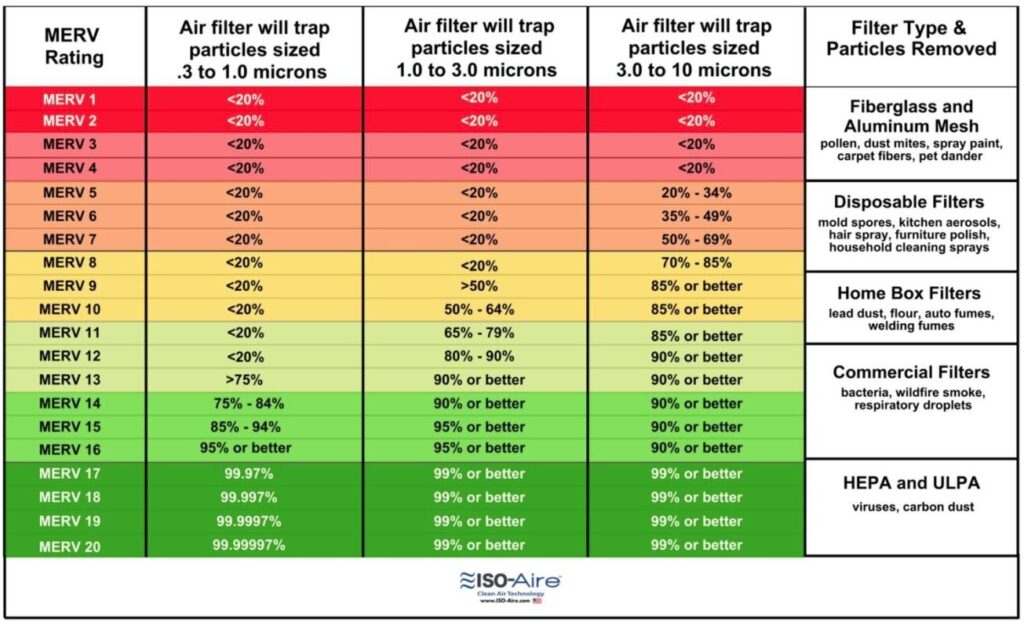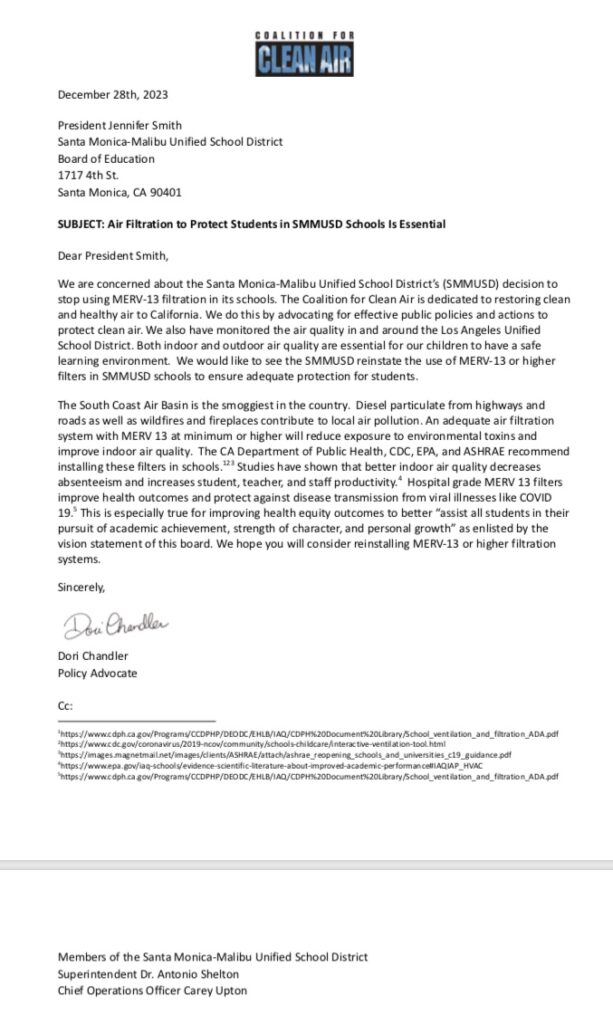A debate has broken out over the quality of clean air in Santa Monica’s public school classrooms. A group of Santa Monica parents and clean air advocates claim that the Santa Monica-Malibu Unified School District is backtracking on promises to provide the cleanest air to students. The District counters that it is following all laws regarding air quality rules and regulations for classrooms and that the air inside its classrooms is clean.
Over the summer break, the District switched from MERV13 filters to the MERV 8 filters in their HVAC units, prompting an outcry from some parents who partnered with environmental and clean air advocates to urge the District to reverse course again and put the MERV 13 filters back.
The HVAC system is designed to use MERV 8 filters. But during the days of social distancing and the original return back to the classrooms in 2021 and 2022 the District switched to stronger MERV 13 filters.
MERV stands for minimum efficiency reporting value and it is a measure of how effective a furnace filter is. Basically, the higher the number, the better the filter. MERV 8 filters are capable of capturing particles as small as 3 microns, including pollen, dust mites, mold spores, and pet dander. MERV 13 filters provide a higher level of filtration and can trap particles as small as 1 micron, including smaller dust particles, bacteria, and some viruses. The federal Environmental Protection Agency recommends the use of MERV 13 filters in classroom settings “if possible.”

“This response has been incredibly disappointing to the community, because we hoped that the District would prioritize the health, well-being and success of our students, teachers and staff, and reinstate MERV 13 filtration to keep students and teachers healthy and in the classroom,” writes Deanne Ozaki, an SMMUSD parent who has organized parents asking for the MERV 13 filters to be reinstalled.
One group who has backed the parents’ effort is the Coalition for Clean Air, who notes that many SMMUSD schools are close to highways and carrier roads that don’t create the healthiest of air.

“Hospital grade MERV 13 filters improve health outcomes and protect against disease transmission from viral illnesses like COVID 19. This is especially true for improving health equity outcomes to better assist students in their pursuit of academic achievement, strength of character and personal growth,” the Coalition writes in a letter which can be read in its entirety here.
SMMUSD has monitors in about ⅓ of its classrooms to monitor the amount of carbon in the air. To minimize the risk of airborne transmission of viruses, it is recommended that CO2 levels stay most close to 400 ppm (outdoor CO2 concentration) and below 800 ppm. The American Society of Heating, Refrigeration, and Air Conditioning Engineers (ASHRAE) recommends that indoor CO2 levels not exceed the local outdoor air concentration by more than 650 ppm, usually 1000 ppm.
“The classrooms where we have CO2 monitors consistently average between 500 ppm and 800 ppm,” wrote Upton in response to a query from Next. “This is a significant sign that there is good airflow.”
But as noted above, airflow and the amount of carbon in the air are not the only concerns that parents have. The smart meters used by the district to measure carbon dioxide aren’t calibrated to measure particulates and viruses that could be in the air. And there is no doubt that the MERV 13 filters would catch far more of those dangers than MERV 8s.
However, there is a cost to using the better filters. SMMUSD explained that with the current HVAC system, using the MERV 13s, an added cost of $300,000 per year.
“During COVID, when all systems were changed to MERV 13 filters, filters were becoming clogged and needing to be replaced no more than every two months, in some cases every month,” writes Carey Upton, the Chief Operating Officer for SMMUSD. “Two skilled maintenance employees (not HVAC techs) were needed to work full time to only replace filters and do minor maintenance on the units. If the filters were not changed, the systems would break or cease to function.”
When SMMUSD was running the units full bore during the heatwave at the start of the 2022 school year, the HVAC systems running MERV 13s “failed en masse,” according to Upton.
“We needed to bring in an outside contractor on emergency status for $350,000 to keep the systems operational,” he wrote. These costs were in addition to what the District would expect to pay in addition to current costs on an annual basis should they switch to MERV 13.
Upton also notes that the district is in compliance with all state and federal laws regarding air quality in classrooms.
At its October 3rd meeting, the SMMUSD Parent Teacher Association requested that the District immediately return to using the MERV 13 filters while they work on a longer-term solution. At its November meeting, the District’s Board of Education rejected that request following Upton’s advice, but did move forward with a request that they look for funding to upgrade their HVAC system or figure out other ways to move back to MERV 13’s.
SMMUSD has applied for state clean air grants that could net them $1.6 million under the California Schools, Healthy Air, Plumbing Efficiency Program (CalSHAPE). They have received word from the state that they are eligible for the grant and are hiring consultants to complete the process. The $1.6 million grant would not be sufficient to immediately replace all of the units, but could be used to measure the effectiveness of current systems, do needed repairs and upgrades to current systems, or even purchase some new equipment.
But there’s a disagreement between parents groups and the District even about this. Parents had pressured the District to apply for the CalSHAPE funds, but were unavailable in early rounds. The District claims to have been unaware it had become eligible until they were pressured by parents at the start of this school year. Upton says that SMMUSD “…appreciates the parent’s letting us know that we were eligible last fall.”
But neither those kind words nor the pending grant application are enough for parents who want the filters to go back now. They note the District’s large budget (over $132.5 million for the current fiscal year) and the allocation the District receives from the City of Santa Monica ($40 million) and believe the funding to use the MERV 13s ought to be available now should it believe this a priority.
“I also do not believe that our students, teachers, and staff should be negatively impacted because our District failed to apply for $1.6 Million in state funding under CalSHAPE for over a year,” writes Ozaki, noting that the District could have applied for CalSHAPE funds in mid-2022.
